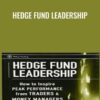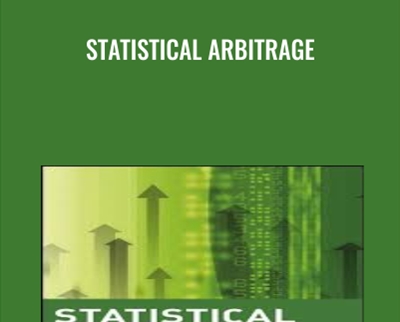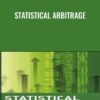$27.00 Original price was: $27.00.$11.00Current price is: $11.00.
While statistical arbitrage has faced some tough times?as markets experienced dramatic changes in dynamics beginning in 2000?new developments in algorithmic trading have allowed it to rise from the ashes of that fire.
 Purchase this course you will earn 11 Points worth of $1.10
Purchase this course you will earn 11 Points worth of $1.10Elevate your skills with the Statistical Arbitrage – Andrew Pole course, available for just $27.00 Original price was: $27.00.$11.00Current price is: $11.00. on Utralist.com! Browse our curated selection of over 60,000 downloadable digital courses across diverse Uncategorized. Benefit from expert-led, self-paced instruction and save over 80%. Start learning smarter today!
Description
While statistical arbitrage has faced some tough times?as markets experienced dramatic changes in dynamics beginning in 2000?new developments in algorithmic trading have allowed it to rise from the ashes of that fire. Based on the results of author Andrew Pole?s own research and experience running a statistical arbitrage hedge fund for eight years?in partnership with a group whose own history stretches back to the dawn of what was first called pairs trading?this unique guide provides detailed insights into the nuances of a proven investment strategy. Filled with in-depth insights and expert advice, Statistical Arbitrage contains comprehensive analysis that will appeal to both investors looking for an overview of this discipline, as well as quants looking for critical insights into modeling, risk management, and implementation of the strategy.
Table of Contents
- Preface.
- Foreword.
- Acknowledgments.
- Chapter 1. Monte Carlo or Bust.
- Beginning.
- Whither? And Allusions.
Chapter 2. Statistical Arbitrage.
- Introduction.
- Noise Models.
- Reverse Bets.
- Multiple Bets.
- Rule Calibration.
- Spread Margins for Trade Rules.
- Popcorn Process.
- Identifying Pairs.
- Refining Pair Selection.
- Event Analysis.
- Correlation Search in the Twenty-First Century.
- Portfolio Configuration and Risk Control.
- Exposure to Market Factors.
- Market Impact.
- Risk Control Using Event Correlations.
- Dynamics and Calibration.
- Evolutionary Operation: Single Parameter Illustration.
Chapter 3. Structural Models.
- Introduction.
- Formal Forecast Functions.
- Exponentially Weighted Moving Average.
- Classical Time Series Models.
- Autoregression and Cointegration.
- Dynamic Linear Model.
- Volatility Modeling.
- Pattern Finding Techniques.
- Fractal Analysis.
- Which Return?
- A Factor Model.
- Factor Analysis.
- Defactored Returns.
- Prediction Model.
- Stochastic Resonance.
- Practical Matters.
- Doubling: A Deeper Perspective.
- Factor Analysis Primer.
- Prediction Model for Defactored Returns.
Chapter 4. Law of Reversion.
- Introduction.
- Model and Result.
- The 75 percent Rule.
- Proof of the 75 percent Rule.
- Analytic Proof of the 75 percent Rule.
- Discrete Counter.
- Generalizations.
- Inhomogeneous Variances.
- Volatility Bursts.
- Numerical Illustration.
- First-Order Serial Correlation.
- Analytic Proof.
- Examples.
- Nonconstant Distributions.
- Applicability of the Result.
- Application to U.S. Bond Futures.
- Summary.
- Appendix 4.1: Looking Several Days Ahead.
Chapter 5. Gauss is Not the God of Reversion.
- Introduction.
- Camels and Dromedaries.
- Dry River Flow.
- Some Bells Clang.
Chapter 6. Interstock Volatility.
- Introduction.
- Theoretical Explanation.
- Theory versus Practice.
- Finish the Theory.
- Finish the Examples.
- Primer on Measuring Spread Volatility.
Chapter 7. Quantifying Reversion Opportunities.
- Introduction.
- Reversion in a Stationary Random Process.
- Frequency of Reversionary Moves.
- Amount of Reversion.
- Movements from Quantiles Other Than the Median.
- Nonstationary Processes: Inhomogeneous Variance.
- Sequentially Structured Variances.
- Sequentially Unstructured Variances.
- Serial Correlation.
- Appendix 7.1: Details of the Lognormal Case in Example.
Chapter 8. Nobel Difficulties.
- Introduction.
- Event Risk.
- Will Narrowing Spreads Guarantee Profits?
- Rise of a New Risk Factor.
- Redemption Tension.
- Supercharged Destruction.
- The Story of Regulation Fair Disclosure (FD).
- Correlation During Loss Episodes.
Chapter 9. Trinity Troubles.
- Introduction.
- Decimalization.
- European Experience.
- Advocating the Devil.
- Stat. Arb. Arbed Away.
- Competition.
- Institutional Investors.
- Volatility Is the Key.
- Interest Rates and Volatility.
- Temporal Considerations.
- Truth in Fiction.
- A Litany of Bad Behavior.
- A Perspective on 2003.
- Realities of Structural Change.
- Recap.
Chapter 10. Arise Black Boxes.
- Introduction.
- Modeling Expected Transaction Volume and Market Impact.
- Dynamic Updating.
- More Black Boxes.
- Market Deflation.
Chapter 11. Statistical Arbitrage Rising.
- Catastrophe Process.
- Catastrophic Forecasts.
- Trend Change Identification.
- Using the Cuscore to Identify a Catastrophe.
- Is It Over?
- Catastrophe Theoretic Interpretation.
- Implications for Risk Management.
- Appendix 11.1: Understanding the Cuscore.
- Bibliography.
- Index.
Forex & Trading – Foreign Exchange Course
You want to learn about Forex?
Foreign exchange, or forex, is the conversion of one country’s currency into another.
In a free economy, a country’s currency is valued according to the laws of supply and demand.
In other words, a currency’s value can be pegged to another country’s currency, such as the U.S. dollar, or even to a basket of currencies.
A country’s currency value may also be set by the country’s government.
However, most countries float their currencies freely against those of other countries, which keeps them in constant fluctuation.
Get Statistical Arbitrage – Andrew Pole, Only Price $15
Tag: Statistical Arbitrage – Andrew Pole Review. Statistical Arbitrage – Andrew Pole download. Statistical Arbitrage – Andrew Pole discount.
Cultivate continuous growth with the Statistical Arbitrage – Andrew Pole course at Utralist.com! Unlock lifetime access to premium digital content, meticulously designed for both career advancement and personal enrichment.
- Lifetime Access: Enjoy limitless access to your purchased courses.
- Exceptional Value: Benefit from savings up to 80% on high-quality courses.
- Secure Transactions: Your payments are always safe and protected.
- Practical Application: Gain real-world skills applicable to your goals.
- Instant Accessibility: Begin your learning journey immediately after buying.
- Device Compatible: Access your courses seamlessly on any device.
Transform your potential with Utralist.com!
Related products
= 85 Points
Uncategorized
= 35 Points
= 85 Points
Uncategorized
= 35 Points
Uncategorized
Cognitive Rehabilitation Therapy: Practical Interventions and Personalized Planning – Jane Yakel
= 85 Points
Uncategorized
Disordered Eating Behaviors: Identify and Treat the Underlying Trauma – Lori Kucharski
= 85 Points
Uncategorized
Optimizing Compliance and Maximizing Revenue for Ophthalmology and Optometry – Jeffrey P. Restuccio
= 85 Points
Uncategorized
= 85 Points





